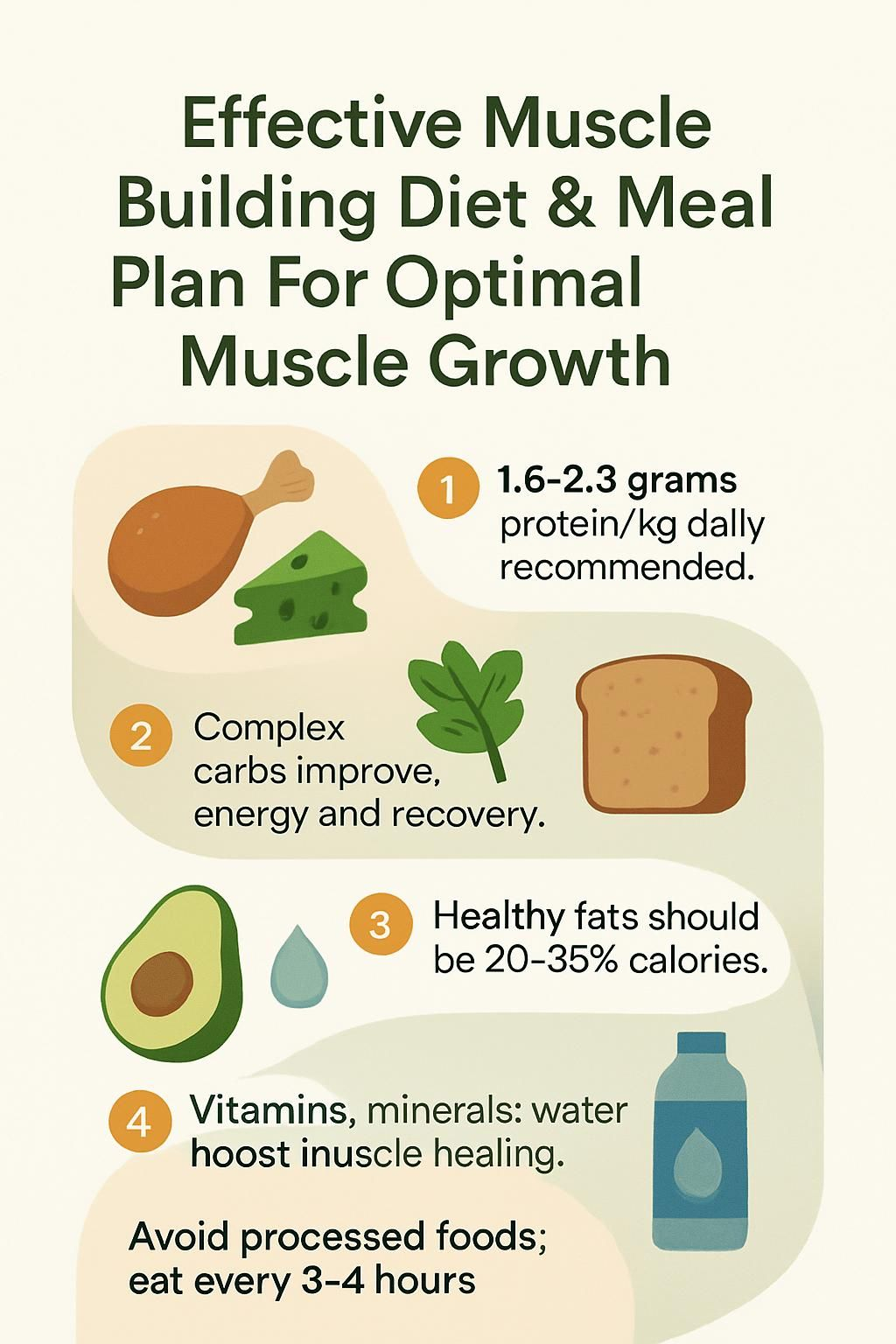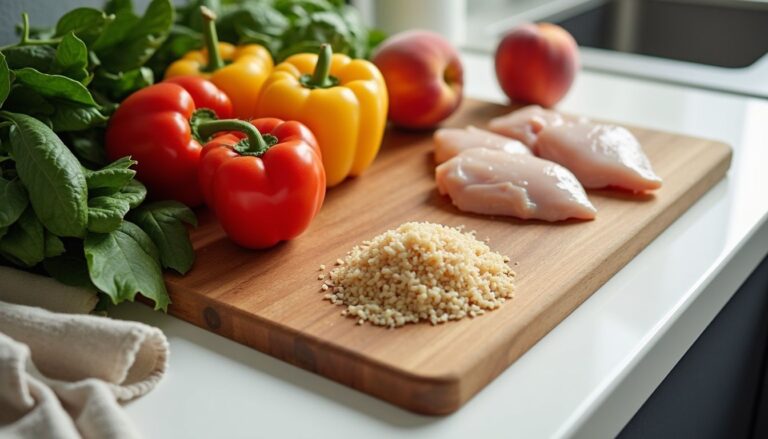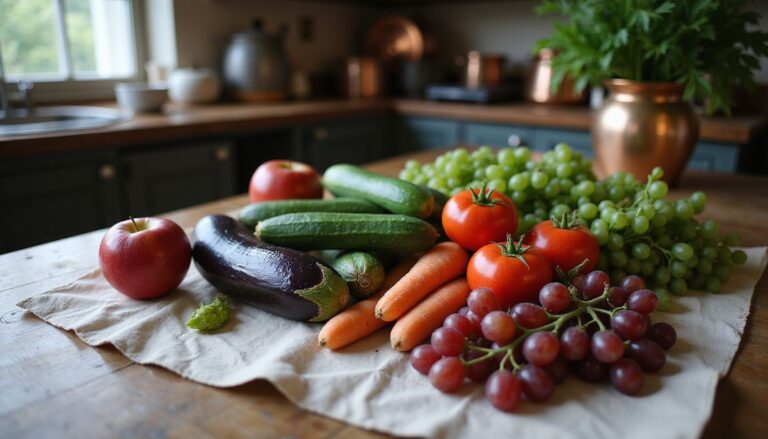Effective Muscle Building Diet & Meal Plan For Optimal Muscle Growth
Our Nutrition Assistant AI Suite will transform your body. You will lose fat, get toned, and build muscle. Gain confidence and optimal health.
If you train hard but still struggle to build muscle, your meals may be the missing piece. A focused muscle building diet can raise strength and lean muscle growth, especially when paired with smart training.
This guide shows you which foods to eat, how to set up a simple meal plan, and the daily habits that speed muscle gain. Use it to turn hard work in the gym into visible results.
Key Takeaways
- Eat 1.6 to 2.2 grams of protein per kilogram of body weight each day from foods like chicken, eggs, and Greek yogurt to drive muscle protein synthesis and lean mass gains (Dietary Guidelines for Americans).
- Choose complex carbohydrates such as oats, brown rice, and sweet potatoes to refill glycogen, support training energy, and improve recovery (Department of Health research).
- Healthy fats, especially omega 3s from salmon or flaxseed, should make up 20 to 35 percent of calories to support hormones, reduce inflammation, and protect joints (Mensink RP et al., 2003).
- Vitamins D, C, B6, and B12, plus minerals like magnesium and potassium, support healing; drink about half an ounce to one ounce of water per pound of body weight daily.
- Limit ultra processed foods high in added sugar and saturated fat. Eating every 3 to 4 hours, with a pre and post workout focus, can improve strength results (Smith et al., Journal of Nutrition 2018).

Why Is Nutrition Important for Muscle Growth?

Food is the raw material your body uses to repair and build muscle after resistance training. Enough dietary protein triggers muscle protein synthesis, the process that rebuilds and strengthens muscle fibers.
A balanced bodybuilding meal plan with the right calorie target helps you gain weight as lean mass, not extra body fat. Large nutrition surveys show that vitamin and mineral gaps can slow recovery and limit muscle hypertrophy, which is muscle size increase.
Carbohydrates fuel tough sets by topping off glycogen, the stored form of sugar in muscle. Healthy fats support key hormones that aid tissue repair. Whole foods bring vitamins and minerals, including vitamin D and calcium, which support bone strength and training performance.
You may notice faster recovery and fewer aches when you add more vegetables, lean meats, dairy foods, beans, and whole grains like brown rice to your weekly plan. Smart sports nutrition protects your gains and reduces muscle loss during hard cycles.
Key Macronutrients for Muscle Building
Your body needs the right mix of protein, carbohydrates, and fat to grow stronger. Knowing how each one works helps you shape a plan that supports muscle gain and better body composition.
How Much Protein Do You Need Daily and What Are the Best Sources?
Most experts recommend 1.6 to 2.2 grams of protein per kilogram of body weight daily when trying to build muscle. If you weigh 150 pounds, aim for about 110 to 150 grams each day.
This range supports muscle repair, helps keep muscle during calorie cuts, and improves strength when paired with steady resistance training. Spread your protein across meals for best results.
Useful protein foods include chicken breast, turkey, eggs, Greek yogurt, salmon, tuna, cottage cheese, tofu, and beans. A whey protein shake can help you hit targets around workouts if food alone falls short.
You cannot out-train a poor diet. Consistent nutrition moves the needle.
What Role Do Carbohydrates Play in Energy and Recovery?
Carbohydrates supply glycogen, your main fuel during lifting and high effort training. Complex carbs like whole grain bread, brown rice, potatoes, fruit, and oats deliver steady energy for longer sessions.
After intense work, a carb rich snack or meal restores glycogen and supports tissue repair. Research shows it can also reduce soreness, which helps you train hard again sooner.
Many lifters notice better performance when they include quality carbs before and after sessions. Skipping carbs can leave you flat halfway through your workout; a bowl of oatmeal or a banana can keep your strength up.
Which Healthy Fats Support Optimal Performance?
Healthy fats help protect muscle and support hormones linked to growth. Focus on unsaturated fats from salmon, walnuts, flaxseed, olive oil, and avocados.
Aim for 20 to 35 percent of daily calories from fat, choosing options that support heart health and inflammation control. Diets higher in omega 3 fats may improve recovery and joint comfort during heavy training.
Choose whole food fat sources and skip fried items or foods high in saturated fat. This simple swap supports both muscle strength and size over time.
Essential Micronutrients for Muscle Growth
Small nutrients do big jobs. Certain vitamins and minerals help your muscles fire, recover, and grow between sessions.
Which Vitamins and Minerals Help with Recovery?
Vitamin D helps your body absorb calcium for strong bones and normal muscle function. Vitamin C is an antioxidant, which means it helps limit inflammation and speeds tissue repair.
B vitamins, especially B6 and B12, support energy production. Minerals matter too. Magnesium helps reduce cramps, potassium supports nerve and muscle action, and zinc plays a role in protein synthesis and immune function.
You can cover many of these with a varied plate: leafy greens for magnesium, dairy or fortified milk for calcium and B12, and bananas or potatoes for potassium. Better recovery means you can push harder in your next workout.
Why Is Hydration Crucial for Muscle Growth?
Water moves nutrients, controls body temperature, and supports tissue repair after training. Even a 1 to 2 percent drop in body weight from sweat can lower power output and focus.
Staying hydrated helps deliver amino acids and minerals to muscle, and it supports protein synthesis. Fluids also cushion joints, which can ease training discomfort. A common guide is to drink about half an ounce to one ounce of fluid per pound of body weight daily if you are trying to gain muscle or improve fitness^1^.
Hydration matters even more if your meals include foods high in added sugar or sodium. Balanced fluids help your body recover and perform at its best.
^1: Department of Health and Human Services; application and health benefit data from peer reviewed exercise physiology studies
Best Foods to Include in a Muscle-Building Diet
Choosing nutrient dense foods makes it easier to increase muscle mass and feel better during training.
What Are the Top Lean Protein Sources?
Skinless chicken breast is a classic choice. A 3 ounce serving has about 26 grams of high quality animal protein with little fat. Turkey breast, white fish like cod or tilapia, and egg whites are lean and efficient too.
Add Greek yogurt and cottage cheese for casein, a slow digesting protein that supports nighttime recovery. For plant based options, use tofu, tempeh, edamame, beans, and lentils.
Lean beef cuts such as top sirloin bring iron and zinc, two minerals that support recovery. Rotate options during the week to keep meals interesting and consistent.
Which Complex Carbohydrates Should You Eat?
Whole grains like brown rice, quinoa, oatmeal, and whole wheat bread give steady energy. Beans, lentils, and chickpeas also count and bring fiber and protein.
Fiber slows digestion, which helps manage blood sugar and keeps you full. Sweet potatoes and other starchy vegetables add potassium and magnesium that support muscle function and repair.
Swapping white bread for whole grain choices can prevent midday energy dips while adding flavor and texture to your meals.
What Are the Best Healthy Fats to Include?
Pick fats that help muscle growth and health: avocados, almonds and peanuts, chia or flaxseed, olive oil, and fatty fish such as salmon.
These foods can lower disease risk while supporting lean mass and recovery. Many lifters enjoy almonds with breakfast oats or salmon at dinner twice per week.
Balance each plate with protein, complex carbohydrates, and nutrient dense fat sources. This mix supports steady energy and better training sessions.
What Dairy and Alternatives Support Muscle Growth?
Low fat milk and Greek yogurt deliver complete protein, which contains all essential amino acids. One cup of milk has about 8 grams of protein plus calcium and vitamin D for bone support during training.
Greek yogurt often provides up to 15 grams of protein per six ounces and includes probiotics that may help gut health. If you avoid dairy, soy milk and pea based drinks offer 7 to 9 grams of protein per cup and are often fortified with calcium and B12.
Registered dietitians note that these foods can raise body weight through lean mass when used in a protein rich diet.
Foods to Limit or Avoid
The right foods help you grow. The wrong ones can slow progress or add body fat you do not want.
Why Avoid Processed Foods?
Many packaged snacks, sweets, and soft drinks are loaded with added sugars, unhealthy fats, and extra sodium. These do not support muscle mass or quality recovery.
Ultra processed foods are often low in key vitamins and minerals. They also crowd out protein rich meals you need for tissue repair. Whole food choices like poultry, eggs, dairy or fortified alternatives, fruits, and vegetables keep calories useful and support your goal to gain muscle.
How Do Sugary Snacks and Beverages Affect Muscle Building?
High sugar snacks and drinks spike insulin, then crash your energy during workouts. These swings can lower training intensity and slow recovery.
Sugary beverages also displace nutrient rich foods, which limits the delivery of vitamins and minerals to working muscles. Diets high in added sugar raise body fat, which makes it harder to gain lean muscle [1]. A simple smoothie made with fruit and Greek yogurt beats soda or candy for growth and energy.
[1]: Peer reviewed research has linked excessive added sugar with increased adiposity and weaker anabolic responses (Smith et al., Journal of Nutrition, 2018).
What Impact Does Alcohol Have on Muscle Recovery?
Alcohol can reduce protein synthesis, the rebuilding step after lifting. Research shows that drinking after training may cut muscle protein synthesis by up to 37 percent compared to no alcohol.
Alcohol also dehydrates you because it acts like a diuretic, which makes you lose fluids faster. Dehydration reduces nutrient delivery to sore tissues and joints. If muscle gain is your target, save drinks for rest days or skip them during heavy blocks.
How Important Are Meal Timing and Frequency?
Good timing helps you train hard and recover well. Think of it as giving your body fuel at the right moments.
When Should You Eat Pre- and Post-Workout Meals?
Eat your pre workout meal 60 to 90 minutes before exercise. Choose complex carbs, moderate protein, and low fat to avoid stomach issues. A balanced pre workout meal can improve both strength and endurance.
Eat your post workout meal within 30 to 60 minutes after training. Pick fast digesting protein like whey, eggs, or dairy, and pair it with quicker carbs such as white rice or fruit. This window helps refill glycogen and supports growth processes. It can also steady hunger so you do not overeat later.
What Are the Benefits of Eating Smaller, Frequent Meals?
Eating every 3 to 4 hours can keep energy steady and support muscle protein synthesis. Include a protein source at each meal or snack.
Many people notice better focus and fewer cravings when they shift from three large meals to four or five balanced meals. Smaller, regular portions also make tracking easier and reduce the urge to graze on low quality snacks.
Role of Dietary Supplements
Supplements can fill gaps, but they work best on top of a strong food first plan. Talk with a health professional if you have a condition, use medication, are pregnant, or are under 18.
What Are the Different Types of Protein Powders?
Whey protein digests fast and contains all essential amino acids needed for repair. Casein digests slowly, which makes it useful before sleep.
Plant based powders come from peas, soy, or brown rice and work well if you avoid dairy. Egg white protein is another dairy free option with a strong amino acid profile.
Isolates usually have more protein and fewer carbs and fats than concentrates. Hydrolysates are broken down for faster absorption after training. Pick a type that fits your diet, taste, and budget, and use it to support, not replace, whole foods.
How Does Creatine Improve Muscle Performance?
Creatine raises phosphocreatine stores in muscle, which helps your body make ATP, the quick energy used for heavy lifts and sprints. Consistent use can improve strength and increase lean body mass faster than diet alone.
Research also shows creatine may reduce signs of muscle damage and improve cellular hydration. Drink enough water while using creatine for best results.
What Are Branched-Chain Amino Acids (BCAAs) and Their Benefits?
Branched chain amino acids are leucine, isoleucine, and valine. They are essential, which means you must get them from food or supplements.
Foods rich in BCAAs include chicken, eggs, dairy, soy foods like tofu and tempeh, and some legumes. Taking 5 to 10 grams before or after training can lower muscle damage by up to 33 percent in studies [1]. Many athletes also report less soreness and better training drive.
[1] Shimomura et al., Journal of Nutrition, 2006.
How Do Omega-3 Fatty Acids Aid Recovery?
Omega 3 fats like EPA and DHA help reduce inflammation after hard exercise. They support joint comfort and blood flow to muscles, which brings nutrients to where they are needed.
Two grams of omega 3s daily may cut soreness by as much as 35 percent in athletes. Get them from salmon, sardines, walnuts, chia seeds, or flaxseed.
Can Caffeine Boost Energy and Focus for Workouts?
Caffeine stimulates your central nervous system, which can sharpen focus and lower perceived effort during training. A dose of 3 to 6 milligrams per kilogram of body weight, taken about 30 minutes before exercise, helps many people lift harder and longer.
Try coffee or a pre workout drink, but avoid it late in the day so it does not disrupt sleep, a key growth tool. Evidence supports caffeine for both endurance and strength [1].
[1] Grgic J. et al., Nutrients, 2019.
Sample 7-Day Meal Plan for Muscle Growth
Use this simple 7 day outline to build balanced plates. Adjust portions to your calorie needs and training schedule.
What Does Day 1’s Breakfast, Lunch, Dinner, and Snacks Look Like?
Breakfast: scrambled eggs, whole grain toast, Greek yogurt, and berries. Add a cup of milk or soy milk.
Lunch: grilled chicken breast, brown rice, and steamed broccoli. Drizzle olive oil for healthy fats.
Snack: low fat cottage cheese with sliced almonds.
Dinner: baked salmon, quinoa, roasted sweet potatoes, and a spinach salad with flaxseed oil.
Evening snack: apple with natural peanut butter to steady energy and curb sweet cravings.
How to Balance Meals and Nutrient Timing on Day 2?
Eat every 3 to 4 hours. Start with a high protein breakfast within an hour of waking. Include lean protein, complex carbs like brown rice or sweet potatoes, and healthy fats at lunch and dinner.
Have a pre workout snack about an hour before training, for example a banana and Greek yogurt. After training, eat within 45 minutes. Pair fast acting carbs with whey protein to boost recovery^1^,^2^.
Drink water before and after activity to support nutrient delivery.
^1 Moore DR et al., J Nutr. 2015. ^2 Areta JL et al., J Physiol. 2013.
What Are High-Protein Meal Examples for Day 3?
Breakfast: scrambled eggs with spinach and whole grain toast, plus Greek yogurt and berries. Mid morning snack: cottage cheese with pineapple or roasted chickpeas.
Lunch: grilled chicken over quinoa with steamed broccoli. Afternoon snack: low fat string cheese or turkey wrapped in lettuce.
Dinner: baked salmon with sweet potato and green beans. Before bed: a small bowl of skyr or a casein rich pudding to support overnight repair.
Meal prepping these choices makes it easier to stay consistent and hit daily targets.
How to Incorporate Variety in Carbohydrate Sources on Day 4?
Rotate your grains and produce. Try brown rice with diced apples at breakfast. Pick quinoa with black beans and roasted corn for lunch. Serve sweet potatoes with steamed broccoli at dinner.
Use 100 percent whole wheat wraps or pitas for snacks. Stir oats or barley into yogurt bowls to add soluble fiber, which helps keep blood sugar steady.^1 Switch fruit colors during the day, for example blueberries in the morning and kiwi later.
^1 Slavin JL. Nutrition. 2005;21(3):411-8.
What Does a Healthy Fat-Focused Day Look Like on Day 5?
Breakfast: eggs cooked in olive oil with avocado. Add steel cut oats topped with chia or flaxseed.
Lunch: grilled salmon over quinoa with walnuts and leafy greens. Dress with olive oil vinaigrette.
Snack: Greek yogurt with almond butter or a handful of mixed nuts. Dinner: roasted chicken thighs, sautéed spinach in coconut oil, and sweet potato wedges.
Diets rich in unsaturated fats support hormone health and recovery^1^. Many people feel fuller and more energized on training weeks that include fatty fish, avocados, and nut butters.
^1 Mensink RP et al., Arterioscler Thromb Vasc Biol, 2003.
How to Plan Pre- and Post-Workout Nutrition on Day 6?
Before training, eat complex carbs like oats or whole grain toast with a moderate protein source such as Greek yogurt or egg whites. Time this meal 1 to 2 hours before exercise.
After training, refill glycogen and deliver protein. Choose grilled chicken or a whey shake plus a fast carb like white rice or fruit within 30 to 60 minutes. Hydrate well before, during, and after to maintain muscle function^1^.
^1 Thomas DT, Erdman KA, Burke LM. J Acad Nutr Diet. 2016;116(3):501–528.
What Should You Know About Cheat Meals on Day 7?
A planned cheat meal can boost motivation and make your plan easier to follow. Keep portions in check so one meal does not derail your week.
Pick a food you enjoy and pair it with protein. For example, add extra vegetables to pizza or enjoy ice cream after a protein rich dinner. Then return to your normal plan at the next meal.
What Are Common Mistakes to Avoid in Muscle-Building Diets?
A few common errors can slow progress. Fixing them keeps your plan on track.
Why Is Adequate Protein Intake Essential?
Protein provides amino acids that repair and build muscle after hard workouts. Aim for 1.6 to 2.2 grams per kilogram of body weight daily for best gains, especially with resistance training.
Lean meats, fish, eggs, dairy, soy foods, and legumes make it easier to hit your target. Falling short can lead your body to break down muscle instead of building it.
How to Avoid Overeating or Undereating Calories?
Track daily calories with a reliable app or food journal. For muscle building, many people do well with 250 to 500 calories above maintenance^1^. Use nutrition labels and measured portions to stay accurate.
Weigh yourself weekly. If weight changes do not match your plan, adjust portions^2^. Choose whole foods rich in protein, healthy fats, and complex carbs to control hunger and fullness^3^.
Sources:
- Helms ER et al., Evidence based recommendations for natural bodybuilding contest preparation, J Int Soc Sports Nutr, 2014.
- Hall KD et al., Quantification of the effect of energy imbalance on bodyweight, Lancet, 2011.
- Harvard T.H. Chan School of Public Health, Healthy Eating Plate & Pyramid (https://www.hsph.harvard.edu/nutritionsource/healthy-eating-plate/).
What Happens When You Neglect Recovery Nutrition?
Skipping recovery meals delays repair. Your muscles miss the amino acids and carbs needed to rebuild, which can raise soreness and injury risk.
Even one missed post workout meal can hurt your next session. Aim to eat protein and carbohydrates within about an hour after training to support muscle growth and steady progress.
What Are Top Tips for Success in Muscle Building?
Simple habits, done daily, make the difference between stalled and steady gains.
How to Track Macronutrient Intake Effectively?
Use a food logging app that draws from credible databases like USDA FoodData Central. Log everything you eat and drink, not just main meals.
Weigh ingredients with a kitchen scale before cooking. Weekly reviews help you see if protein, carb, and fat targets line up with your goals.
Why Is Prioritizing Sleep and Recovery Important?
Muscles grow while you sleep. Adults who get 7 to 9 hours a night often see better strength gains and fewer injuries.
Too little sleep raises inflammation and makes cravings harder to control. A small protein rich snack before bed, such as Greek yogurt or casein, can support overnight repair.
How to Stay Consistent with Meal Planning?
Pick one day each week to batch cook and portion meals. Keep quick protein staples on hand like chicken breast, eggs, lentils, and Greek yogurt.
Plan plates that combine lean protein, complex carbs such as brown rice or sweet potatoes, and healthy fats like avocado or olive oil. Store meals in labeled containers so you can grab and go before work or training.
Conclusion
Building muscle takes more than workouts. A clear meal plan with the right protein, carbs, and healthy fats powers training and recovery. Micronutrients and water keep your muscles working well.
Time meals around workouts, favor whole foods, and limit highly processed choices. Small, steady changes add up. Stay consistent with planning, and your effort in the gym will show as real gains in muscle mass and strength.
FAQs
1. What are the key nutrients in an effective muscle building diet for optimal muscle growth?
A balanced meal plan for muscle gain should include high-quality proteins such as chicken breast or salmon, complex carbohydrates like brown rice or oats, and healthy fats from sources such as olive oil or avocados. Research shows that protein intake of 1.6 to 2.2 grams per kilogram of body weight supports lean tissue development (Morton et al., 2018). Carbohydrates help fuel workouts while fats support hormone production.
2. How many meals should I eat each day to build muscle efficiently?
Consuming three main meals with two snacks helps maintain steady energy levels and provides regular amino acid delivery to muscles throughout the day. Studies suggest spreading protein intake across four to six eating occasions can maximize synthesis rates (Areta et al., 2013).
3. Can you provide a sample daily meal plan for someone aiming for optimal muscle growth?
A typical day may start with scrambled eggs and whole grain toast at breakfast; grilled turkey breast, quinoa, and steamed broccoli at lunch; Greek yogurt with berries as a snack; baked cod fillet, sweet potato, and green beans at dinner; cottage cheese before bed. This approach ensures consistent nutrient supply.
4. Is calorie tracking important in a muscle building diet plan?
Monitoring calories is vital because gaining lean mass requires a slight caloric surplus without excessive fat gain. Tracking food intake using apps or journals helps ensure you meet your target range based on your age, activity level, and goals (Helms et al., 2014).
Summary: An evidence-based approach highlights the importance of quality proteins like salmon or chicken breast along with complex carbs such as oats plus healthy fats from avocados in every meal plan designed for optimal muscular gains. Eating several times daily spreads out nutrients effectively while monitoring calories keeps progress on track without unwanted fat increase.







